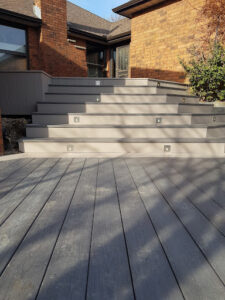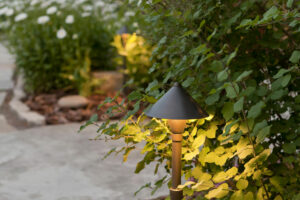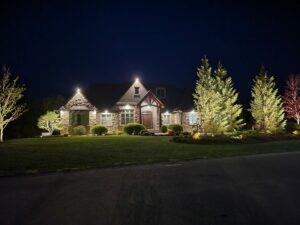For a long time, light was merely a functional necessity in our daily lives. However, over time, artists and designers globally have delved into the study of light’s properties and its ability to accentuate shapes and textures. Today, we witness the evolution of light into an art form known as luminism or light art. This transformative approach uses light as the “paintbrush” to either produce illuminated sculptures or craft “sculptures” through the interplay of light, colors, and shadows. In the realm of outdoor spaces, this artistry finds expression in landscape lighting techniques, particularly shadowing and silhouetting, which create visually appealing and emotionally inspiring designs.
The Essence of Light Art in Landscapes
Landscape lighting isn’t merely about functionality; it’s an art form that reveals and creates beauty. The two primary ways to make landscape lighting beautiful are:
Reveal Existing Beauty: Illuminate the inherent beauty of your landscape, from architectural features to unique yard elements.
Create New Beauty: Use light and shadow creatively to sculpt new visual elements, turning your outdoor space into an artistic canvas.
One accessible way to bring this artistry into your hands is through decorative area lights. These fixtures are captivating not only during the day but also when lit, project intricate patterns of light and shadows, setting the mood and providing ambiance. Bollards and path lights, adorned with intricate designs, exemplify how well-designed lighting can create impressive visual elements.
Decorative Area Lights: Sculpting with Light and Shadow
Decorative area lights, such as bollards and path lights, serve multiple purposes depending on their placement:
In Gardens: Positioned for beautiful illumination on surrounding plants and vegetation.
At Landscape Features: Set at the corners of landscape features for area lighting on decks, patios, etc.
Along Walkways: Placed along walkways or entryways for path lighting.
These lights project their patterns 360 degrees, both downward and upward, making them versatile for creating artistic, geometric patterns. Proper placement, especially near walls or large surfaces, maximizes the visual impact of these patterns, turning your outdoor space into an enchanting wonderland.
Lighting Techniques: Elevating Your Outdoor Experience
Moonglow Lightscapes understands the transformative power of lighting techniques. Two notable techniques that elevate the outdoor experience are shadowing and silhouetting in outdoor lighting.
1. Shadow Lighting: Unveiling Textures and Shapes
Shadowing involves placing lights strategically to cast shadows of trees, statues, or other features against a wall or background. This technique is particularly popular for lighting trees, shrubbery, and sculptures. Different angles create diverse effects, and when a tree or plant is highlighted, the movement reflected in the shadow becomes mesmerizing. Professional lighting designers understand how to utilize shadowing to bring out the best in your property, highlighting areas you might not have considered.
2. Silhouetting: Embracing Negative Space
Silhouetting lighting design plays with positive and negative space, making the darker, recessed portions the focal point. By backlighting a background, whether a house, wall, or fence, the plant or feature in front appears dark against the well-lit background, creating a stunning silhouette. This technique adds drama and depth to a property, especially when highlighting unique plant life with intriguing forms and structures.
Adding Drama to Your Property: Unique Lighting Techniques
Beyond shadowing and silhouetting, there are other techniques that outdoor lighting designers use to create ambiance and drama:
Wall-Wash Lighting: Delivers subtle, low light to a wide area, creating a beautiful visual appeal on structures.
Grazing: Adds depth and dimension to stucco, brick, stonework, or architectural features.
In-ground Lighting: Illuminates permanent installations like sidewalks, large trees, walls, and flagpoles.
Hardscape Lighting: Highlights stone features, retaining walls, outdoor kitchens, steps, handrails, benches, and more.
Landscape Lighting Techniques for Different Applications
Depending on your application, whether it’s xeriscape lighting, path and spread lighting, or deck and patio lighting, there are specific techniques tailored to create the desired effect:
Xeriscape Lighting: Benefits cacti, grasses, and stone with lower lumen illumination than traditional landscaping.
Path & Spread Lighting: Illuminates sidewalks, stone pathways, and lawn walkways while adding intrigue to boulders and plant beds.
Deck & Patio Lighting: Accentuates the beauty of decks, patios, outdoor kitchens, steps, handrails, and other vertical features.
Illuminate Your Dreams with Professional Design
Understanding your property and identifying key areas to focus on can transform your home or business into a dream landscape. If you’re unsure where to start, collaborating with a professional lighting designer, like those at Moonglow Lightscapes, can make a significant difference. Professionals perform initial consultations and install temporary lighting designs, allowing you to witness firsthand what shadowing and silhouetting can do for your space.
In conclusion, the play of light and shadow is a powerful tool in creating a visually appealing outdoor space. Landscape lighting techniques, from shadowing to silhouetting, open up a realm of artistic possibilities. Whether you’re revealing the beauty already present or creating new beauty through light and shadow, the result is an enchanting canvas that transforms your outdoors into a masterpiece.
For a free consultation and to discover the magic of shadowing and silhouetting, contact Moonglow Lightscapes today. Your dream landscape lighting design is just a click away.


